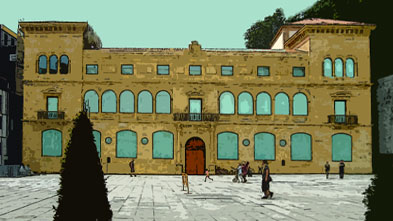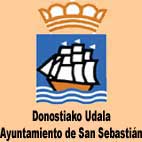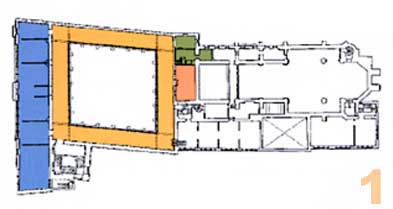
|
|
|||
 |
|||
VISITING HOURS Tuesday - Saturday: 10.30 a.m. - 13.30 p.m. 16.00 p.m. - 19.30 p.m. Sundays and holidays: 10.30 a.m. - 14.00 p.m. Mondays closed Groups Tel. 943 48 15 76 |
|||
|
HISTORY
One
of the most outstanding characteristics of the municipal museum of San
Telmo is the building itself in which the museum is housed. Here we have
a former Dominican friary, built at the foot of Monte Urgull in the mid
sixteenth century. It was thanks to the patronage of Alonso de Idiaquez,
a nobleman of Gipuzkoa and State Secretary to the Emperor CharlesV, that
the building was commenced in 1544, finishing in 1562. An analysis of the
structure of the museum shows that the style of architecture is one of
transition from the Gothic to the Renaissance, for although the structure
is Gothic, the ground plan incorporates a series of Renaissance characteristics.
One of the most original features of this former friary is the location
of the cloister. This is usually found on one side of the church, but here,
due to the proximity of theMount, it is directly in front of the
church entrance. In 1813 the city of Donostia-San Sebastian was put to
sack and ruin, the Friary being badly damaged; and as from 1821 part of
it was used as an artillery barracks. In 1836, after the alienation enforced
by Mendizabal, the friars were expelled. In 1913 the building was declared
historical monument, and bought by the Town Hall in 1928 to be inaugurated
in 1932 as a museum.
In 1902 a series of art works collected for their Ethnological and Fine Arts Museum was installed in San Telmo by the Real Sociedad Vascongada de Amigos del Pais (Royal Society of Friends of the Basque Country). This collection had formerly been housed in a building between Garibay and Andia Streets, and later in anotherin Urdaneta Street in 1909. |
|||
LAS TRES PLANTAS DEL MUSEO |
|||
|
THE MUSEUM
The
museum has a ground floor and two storeys. The ground floor comprises
of the church and lower cloister, with the Archeology Section, exhibition
halls and entrances. The first floor accomodates a good ethnographical
collection and a picture gallery (with paintings from the Gothic age to
the 20th century). Finally, the second storey is dedicated in its entirety
to contemporary Basque painting. Sculptures are also to be found in several
parts of the museum. Architecturally, the two most important parts of the
museum are the cloister and the church. In the latter, XVIth century architecture
and the XXth century Sert canvases combine harmoniously.
|
|||
|
SAN TELMO MUSEOA - MUSEO SAN TELMO Plaza Zuloaga, 1 20003 DONOSTIA-SAN SEBASTIAN GIPUZKOA ESPAÑA Tel.: 943 48 15 80 - Fax: 943 48 15 81 |
|||
amigosdelmuseosantelmo@gmail ast@amigosdesantelmo.org |
|||

|
|||

|
|||
|
|



